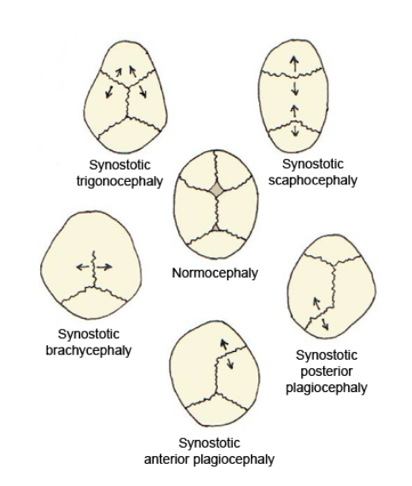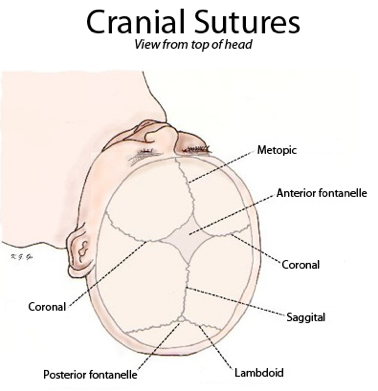|
Oxycephaly
Turricephaly is a type of cephalic disorder where the head appears tall with a small length and width. It is due to premature closure of the coronal suture plus any other Suture (anatomy), suture, like the Lambdoid suture, lambdoid, or it may be used to describe the premature fusion of all sutures. It should be differentiated from Crouzon syndrome. Oxycephaly (or acrocephaly) is a form of turricephaly where the head is cone-shaped, and is the most severe of the Craniosynostosis, craniosynostoses. Presentation Common associations It may be associated with: * Vestibulocochlear nerve#Symptoms of damage, 8th cranial nerve lesion * Optic nerve compression * Intellectual disability * Syndactyly Conditions with turricephaly Conditions with turricephaly include: * Achondrogenesis, type IA * Elejalde syndrome, Acrocephalopolydactyly * Carpenter syndrome, Acrocephalosyndactyly type V (Goodman syndrome) * Acrocraniofacial dysostosis * Alopecia - contractures - dwarfism - intellectual disabili ... [...More Info...] [...Related Items...] OR: [Wikipedia] [Google] [Baidu] |
Craniorhiny
Craniorhiny is a rare autosomal dominant syndrome characterized by craniosynostosis (oxycephaly) and facial anomalies around the nose base and lips. Signs and symptoms Features of this condition include: * Head or neck: anteverted nares, wide nose, recessed forehead * Integument: nasal hirsutism * Musculoskeletal system: craniosynotosis, oxycephaly/turricephaly Infranasal spherical cyst-like formations with Fistula, fistulas have also been seen. History The first (and only confirmed) reports of this condition was made in 1991, seen in a father and son. Two siblings reported in 2007 are also speculated to have the condition. References Rare diseases Syndromes {{Genetic-disorder-stub} ... [...More Info...] [...Related Items...] OR: [Wikipedia] [Google] [Baidu] |
Craniosynostosis
Craniosynostosis is a condition in which one or more of the fibrous sutures in a young infant's skull prematurely fuses by turning into bone (ossification), thereby changing the growth pattern of the skull. Because the skull cannot expand perpendicular to the fused suture, it compensates by growing more in the direction parallel to the closed sutures. Sometimes the resulting growth pattern provides the necessary space for the growing brain, but results in an abnormal head shape and abnormal facial features. In cases in which the compensation does not effectively provide enough space for the growing brain, craniosynostosis results in increased intracranial pressure leading possibly to visual impairment, sleeping impairment, eating difficulties, or an impairment of mental development combined with a significant reduction in IQ. Craniosynostosis occurs in one in 2000 births. Craniosynostosis is part of a syndrome in 15% to 40% of affected patients, but it usually occurs as an isol ... [...More Info...] [...Related Items...] OR: [Wikipedia] [Google] [Baidu] |
Crouzon Syndrome
Crouzon syndrome is an autosomal dominant genetic disorder known as a branchial arch syndrome. Specifically, this syndrome affects the first branchial (or pharyngeal) arch, which is the precursor of the maxilla and mandible. Because the branchial arches are important developmental features in a growing embryo, disturbances in their development create lasting and widespread effects. The syndrome is caused by a mutation in a gene on chromosome 10 that controls the body's production of fibroblast growth factor receptor 2 (''FGFR2''). Crouzon syndrome is named for Octave Crouzon, a French physician who first described this disorder. First called "craniofacial dysostosis" ("craniofacial" refers to the skull and face, and " dysostosis" refers to malformation of bone), the disorder was characterized by a number of clinical features which can be described by the rudimentary meanings of its former name. The developing fetus's skull and facial bones fuse early or are unable to expand. Thu ... [...More Info...] [...Related Items...] OR: [Wikipedia] [Google] [Baidu] |
Craniosynostosis And Dental Anomalies
Craniosynostosis and dental anomalies (CRSDA, also known as Kreiborg-Pakistani syndrome) is an autosomal recessive syndrome characterized by craniosynostosis, maxillary hypoplasia, and dental anomalies. Dental anomalies seen in this condition include malocclusion, delayed and ectopic tooth eruption, and/or supernumerary teeth. Syndactyly, clinodactyly, and other digit anomalies may also be present. Signs and symptoms Features of this condition include, by area affected: * Head or neck: convex nasal ridge, delayed tooth eruption, dental crowding, dental malocclusion, depressed nasal bridge, downslanted palpebral fissures, flat forehead, high forehead, high palate, mandibular prognathia, midface retrusion, narrow palate, sloping forehead, supernumerary teeth, and wide nose * Limbs: two or three-toe syndactyly, broad hallux, clinodactyly, hallux valgus, short phalanx of finger * Eyes: hypertelorism, pailledema, proptosis * Immune system: chronic otitis media * Integument: fingerna ... [...More Info...] [...Related Items...] OR: [Wikipedia] [Google] [Baidu] |
Potocki–Shaffer Syndrome
Potocki–Shaffer syndrome (PSS), also known as DEFECT11 syndrome or chromosome 11p11.2 deletion syndrome, is a rare contiguous gene syndrome that results from the microdeletion of section 11.2 on the short arm of chromosome 11 (11p11.2). The syndrome has its name from Dr. Lorraine (Lori) Potocki and Dr. Lisa Shaffer who discovered the deletion on the 11th chromosome and studied the impacts. The deletion of this combination of genes results in several distinctive congenital features, occasional defects in the heart, kidneys, and urinary tract. The disorder is associated with an enlarged parietal foramina which can cause openings in the two bones that form the top and sides of the skull. These abnormal openings form extra "soft spots" on the head, in addition to the two that newborns normally have, and unlike the usual newborn soft spots, the enlarged parietal foramina remain open throughout life. Other signs can include multiple mostly noncancerous benign bone tumours called o ... [...More Info...] [...Related Items...] OR: [Wikipedia] [Google] [Baidu] |
Gómez–López-Hernández Syndrome
Gómez–López-Hernández syndrome (GLH) or cerebellotrigeminal-dermal dysplasia is a rare neurocutaneous ( Phakomatosis) disorder affecting the trigeminal nerve and causing several other neural and physical abnormalities. Gómez–López-Hernández syndrome has been diagnosed in only 34 people. Cases of Gómez–López-Hernández syndrome may be under-reported as other diseases share the characteristics of cerebellar malformation shown in Gómez–López-Hernández syndrome. Gómez–López-Hernández syndrome was first characterized in 1979. Presentation Physical Physical characteristics of the syndrome can vary and are not universal. People with Gómez–López-Hernández syndrome often have a short skull (brachycephaly), thin lips, low-set and posterior-angled ears, and scalp alopecia above both ears. This bilateral scalp alopecia is the most consistent physical characteristic of Gómez–López-Hernández syndrome. In addition to the shortness of the skull, it is also mis ... [...More Info...] [...Related Items...] OR: [Wikipedia] [Google] [Baidu] |
Dominance (genetics)
In genetics, dominance is the phenomenon of one variant (allele) of a gene on a chromosome masking or overriding the effect of a different variant of the same gene on the other copy of the chromosome. The first variant is termed dominant and the second is called recessive. This state of having two different variants of the same gene on each chromosome is originally caused by a mutation in one of the genes, either new (''de novo'') or inherited. The terms autosomal dominant or autosomal recessive are used to describe gene variants on non-sex chromosomes ( autosomes) and their associated traits, while those on sex chromosomes (allosomes) are termed X-linked dominant, X-linked recessive or Y-linked; these have an inheritance and presentation pattern that depends on the sex of both the parent and the child (see Sex linkage). Since there is only one Y chromosome, Y-linked traits cannot be dominant or recessive. Additionally, there are other forms of dominance, such as incomp ... [...More Info...] [...Related Items...] OR: [Wikipedia] [Google] [Baidu] |
Multiple Epidermal Growth Factor-like Domains 8
''Megf8'' also known as Multiple Epidermal Growth Factor-like Domains 8, is a protein coding gene that encodes a single pass membrane protein, known to participate in developmental regulation and cellular communication. It is located on chromosome 19 at the 49th open reading frame in humans (19q13.2). There are two isoform constructs known for MEGF8, which differ by a 67 amino acid indel. The isoform 2 splice version (analyzed throughout this page) is 2785 amino acids long, and predicted to be 296.6 kdal in mass. Isoform 1 is composed of 2845 amino acids and predicted to weigh 303.1 kdal. Using BLAST (biotechnology), BLAST searches, orthologs were found primarily in mammals, but MEGF8 is also conserved in invertebrates and fishes, and rarely in birds, reptiles, and amphibians. A notably important paralog to multiple epidermal growth factor-like domains 8 is ATRNL1 (Attractin-like 1), which is also a single pass transmembrane protein, with several of the same key features and mot ... [...More Info...] [...Related Items...] OR: [Wikipedia] [Google] [Baidu] |
Zellweger Syndrome
Zellweger syndrome is a rare congenital disorder characterized by the reduction or absence of functional peroxisomes in the cells of an individual. It is one of a family of disorders called Zellweger spectrum disorders which are leukodystrophy, leukodystrophies. Zellweger syndrome is named after Hans Zellweger (1909–1990), a Swiss-American pediatrician, a professor of pediatrics and genetics at the University of Iowa who researched this Disease, disorder. Signs and symptoms Zellweger syndrome is one of three peroxisome biogenesis disorders that belong to the Zellweger spectrum of peroxisome biogenesis disorders (PBD-ZSD). The other two disorders are neonatal adrenoleukodystrophy (NALD), and infantile Refsum disease (IRD). Although all have a similar molecular basis for disease, Zellweger syndrome is the most severe of these three disorders. Zellweger syndrome is associated with impaired neuronal migration, neuronal positioning, and brain development. In addition, individuals ... [...More Info...] [...Related Items...] OR: [Wikipedia] [Google] [Baidu] |
Immune Dysregulation
In biology, immunity is the state of being insusceptible or resistant to a noxious agent or process, especially a pathogen or infectious disease. Immunity may occur naturally or be produced by prior exposure or immunization. Innate and adaptive The immune system has innate and adaptive components. Innate immunity is present in all metazoans, immune responses: inflammatory responses and phagocytosis. The adaptive component, on the other hand, involves more advanced lymphatic cells that can distinguish between specific "non-self" substances in the presence of "self". The reaction to foreign substances is etymologically described as inflammation while the non-reaction to self substances is described as immunity. The two components of the immune system create a dynamic biological environment where "health" can be seen as a physical state where the self is immunologically spared, and what is foreign is inflammatorily and immunologically eliminated. "Disease" can arise when what ... [...More Info...] [...Related Items...] OR: [Wikipedia] [Google] [Baidu] |
Saethre–Chotzen Syndrome
Saethre–Chotzen syndrome (SCS), also known as acrocephalosyndactyly type III, is a rare congenital disorder associated with craniosynostosis (premature closure of one or more of the sutures between the bones of the Human skull, skull). This affects the shape of the head and face, resulting in a cone-shaped head and an asymmetrical face. Individuals with SCS also have droopy eyelids (Ptosis (eyelid), ptosis), widely spaced eyes (hypertelorism), and minor abnormalities of the hands and feet (syndactyly). Individuals with more severe cases of SCS may have mild to moderate intellectual or learning disabilities. Depending on the level of severity, some individuals with SCS may require some form of medical or surgical intervention. Most individuals with SCS live fairly normal lives, regardless of whether medical treatment is needed or not. Signs and symptoms SCS presents in a variable fashion. The majority of individuals with SCS are moderately affected, with uneven facial features and ... [...More Info...] [...Related Items...] OR: [Wikipedia] [Google] [Baidu] |
Spondyloenchondrodysplasia
Spondyloenchondrodysplasia is the medical term for a rare spectrum of symptoms that are inherited following an autosomal recessive inheritance pattern. Skeletal anomalies (including abnormal bone growths) are the usual symptoms of the disorder, although its phenotypical nature is highly variable among patients with the condition, including symptoms such as muscle spasticity or thrombocytopenia purpura. It is a type of immunoosseous dysplasia. Signs and symptoms Heterogeneity in this disorder causes the phenotype and severity of the symptoms caused by the disorder to vary widely among patients with the condition, these subsets of symptoms include those affecting the immune system (causing autoimmune diseases and resulting in the disruption of other systems such as the hematological one), the neurological system, and many more. Skeletal symptoms This condition primarily constitutes skeletal anomalies. These include metaphyseal dysplasia, platyspondyly and the presence of les ... [...More Info...] [...Related Items...] OR: [Wikipedia] [Google] [Baidu] |






